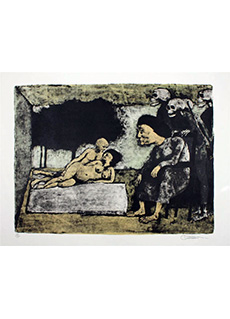
 Spanish and American
Spanish and American
Federico Castellón (Spanish and American, 1914-1971) was a printmaker, painter, and illustrator. Born in Almeria, Spain, his family immigrated to Brooklyn, New York when he was seven. Castellón was primarily self-taught and would often visit museums and galleries to study the old masters and modern works. Unable to fit in at school because of his immigrant background and accent, the young artist concentrated on his artwork and produced a large body of work by his young adulthood. Castellón first broke into the art scene when he was awarded a Medal of Art and grant to produce a mural for Erasmus High School. The mural was so well done that it drew critical acclaim and was exhibited at Raymond & Raymond Galleries in New York before being permanently installed at the school.
Sacrificial Seed by Federico Castellon (Spanish and American, 1914-1971). Limited edition lithograph print numbered 137 of 150. Pencil signed by the artist. A deeply emotional print depicting a theme of life and death.
Size: 16 1/2" h x 22" w (image); 22" h x 30" w (sheet)
Condition: Very good. Small creases and soft handling creases.
Federico Castellón (Spanish and American, 1914-1971) was a printmaker, painter, and illustrator. Born in Almeria, Spain, his family immigrated to Brooklyn, New York when he was seven. Castellón was primarily self-taught and would often visit museums and galleries to study the old masters and modern works. Unable to fit in at school because of his immigrant background and accent, the young artist concentrated on his artwork and produced a large body of work by his young adulthood. Castellón first broke into the art scene when he was awarded a Medal of Art and grant to produce a mural for Erasmus High School. The mural was so well done that it drew critical acclaim and was exhibited at Raymond & Raymond Galleries in New York before being permanently installed at the school.
Not long after, Castellón met Diego Rivera when Rivera was in New York for the installation of the Rockefeller murals, and Rivera’s mentorship was instrumental in launching his career. Rivera introduced the young artist to the director of Weyhe Gallery in Manhattan, where Castellón secured his first solo exhibition. In 1934, also with Rivera's help, Castellón was awarded a four-year traveling fellowship to study in Europe.
Castellón also found mentorship from the printmaker George C. Miller whom he met in 1938 in Paris. In 1940, Castellón was included in an exhibit at the Chicago Art Institute and the Whitney Museum. He received the first of two Guggenheim Fellowships, which allowed him to travel and study extensively throughout the U.S. In 1943, Castellón became a permanent U.S. citizen and was drafted into the Army and sent to China and India, places that influenced his art. In 1946, he taught at Columbia University and for the next 14 years, taught courses at Pratt Institute and Queens College. In 1952, he moved with his wife and children to Europe and returned in 1954 to complete a lecture tour of South America, hosted by the U.S. State Department.
Castellón continued to teach, study, and exhibit throughout the 60s. He was elected membership to the National Academy of Design in New York and awarded First Prize from the Library of Congress. Federico Castellón died in New York on July 7, 1971. His work is included in major museums and collections worldwide.